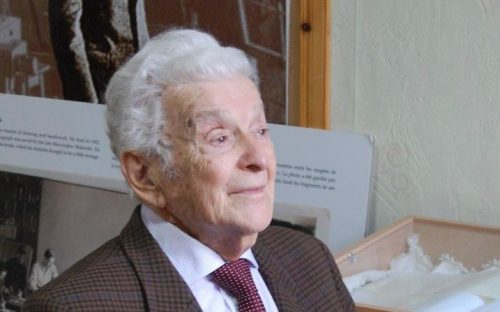Nash Holos: The Extraordinary Alfred Schreyer
Welcome to Ukrainian Jewish Heritage on Nash Holos Ukrainian Roots Radio. I’m Peter Bejger.
Imagine everything that is dear to you in life has been lost. Imagine your world destroyed. And imagine if you can find the strength to move ahead. In 2011 the Austrian director Paul Rosdy released his film The Last Jew from Drohobych. The documentary chronicles the astonishing path of one man’s journey through the treacherous history of Eastern Europe.
 Alfred Schreyer was born in 1922 in Drohobych, a thriving town then in Poland, and now in Western Ukraine. His mother Leontina was a pharmacist. His father Benno had a doctorate from the University of Zurich and was a chief chemist at an oil refinery. Both were very musical and Alfred learned to play the cello.
Alfred Schreyer was born in 1922 in Drohobych, a thriving town then in Poland, and now in Western Ukraine. His mother Leontina was a pharmacist. His father Benno had a doctorate from the University of Zurich and was a chief chemist at an oil refinery. Both were very musical and Alfred learned to play the cello.
Later, in high school, Alfred was a student of the world-renowned writer and painter Bruno Schulz. Just like Alfred, Bruno Schulz spent most of his life in Drohobych. Schulz’s acclaimed books, The Street of Crocodiles and The Sanatorium Under the Sign of the Hourglass, both now translated into many languages, can still be felt and seen on every street corner in Drohobych.
The outbreak of the Second World War however turned Drohobych upside down.
Yet life continued. Alfred graduated from high school in 1940, during the first Soviet occupation of Western Ukraine. He earned his first money in a vocal quartet.
After the German army arrived in June 1941, five forced labour camps were established in Drohobych. Alfred worked in a carpentry workshop in a nearby village. The family had to leave their home and move into the ghetto.
The killings soon started. At first smaller groups of Jews were assembled and then shot in the forest. On August 5, 1942, five thousand Jews from Drohobych were deported to Belzec and gassed. Among them were Alfred’s father, an uncle, a grandmother, and an aunt.
And in November 1942 Alfred’s teacher Bruno Schulz was shot by a Gestapo officer in the streets of Drohobych.
In 1943, three forced labour camps were liquidated all on one day. Eleven thousand Jews from Drohobych and its surroundings were shot in the woods. Alfred’s mother was among them.
Alfred, young and still strong, was forced to work in a Ceramic Workshop camp and later at the Carpathian Oil Corporation, the last forced labour camp in Drohobych.
In April 1944 the front lines of the war were once again nearing Drohobych. Alfred and all the other workers were sent further west to concentration camps in Germany. Suddenly one day near Leipzig the prisoners were told to march. There was no destination. This was a death march. Alfred survived by his wits and good luck.
After the war ended Alfred had a chance to go to Argentina, where there was an aunt and an uncle. But when he saw the barracks of the Red Cross in Berlin, he decided spontaneously to return to Drohobych.
Absolutely nothing was left of Alfred’s former life in Drohobych. But he found a new home in the local Cinema Lobby Orchestra. Alfred’s orchestra had a singer and eleven musicians—three saxophones, two trumpets and trombone, piano, drums, accordion, violin, and bass. They played overtures, songs, waltzes, and special arrangements when a music film was in the schedule. The orchestras would play in the lobby for thirty to forty minutes before screening time. Each week there was a new music program.
Alfred never lost his optimism. He had lost everything but his life. And he moved his life forward in a beautiful way. Through music. He found his luck, despite everything, in the Cinema Lobby Orchestra.
Alfred Schreyer passed away on April 25, 2015. His extraordinary story reflects a life caught between tragedy and resilience. A life that transcended the toxic hatreds of the 20th century.
This has been Ukrainian Jewish Heritage on Nash Holos Ukrainian Roots Radio. From San Francisco, I’m Peter Bejger. Until next time, shalom!
Listen to the audio here.



















